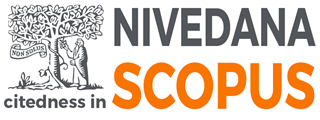THE STUDY ON SIMILE IN PĀLI LITERATURE
Types and Its Significances)
Abstract
This research aims to study the use of similes in the Pāli Literature, analyzing their types and their significance. It is qualitative research that is carried out with a library approach, by collecting the data from primary sources like Tipiṭaka and other Pāli treatises as well as secondary sources such as books, journals, and academic articles. By utilizing this method, this research collects the data relevant to the topic and examines it to produce a comprehensive study of the similes in the Pāli Literature, discovering the types and their significance. Simile (upamā) is a figure of speech comparing two things, showing the similarities. In Pāli literature, the simile is used for two functions as a decorative or embellishment (alaṅkāra) of the language and as a means used to convey the meaning of philosophical teaching (atthassa viññāpanāya) or to elucidate the meaning (atthasandassanī). Subodhālaṅkāra provides valuable information for the types of similes identified from the Buddhist perspective. Examining the Sutta Pitaka, it is discovered many types of similes have been used by the Buddha which can be classified according to their nature and characteristics such as similes on nature, similes on animals, similes on person, and similes on material. The Buddha’s use of simile as a teaching method demonstrates his skillfulness in his teaching approach. The use of similes in teaching methods plays a significant role in creating an effective learning process that enables the students to understand the lesson easily.
References
Anderson, D. and Smith, H. (Ed). (1913). Sutta Nipāta. London: Pali Text Society.
Chalmers, Robert (Ed). (1977). Majjhima Nikāya Vol. II. London: Pali Text Society.
Chandaratana Thero, Dapane. (2015). The use of Upamā as a partial theory of knowledge in early Buddhism. Proceedings of the International Postgraduate Research Conference 2015 University of Kelaniya, 121.
Davids, Rhys T.W. and J. Estlin Carpenter (Eds). (1966). Dīgha Nikāya Vol. II. London: Pali Text Society.
Fadaee, E. (2011). Symbols, metaphors and similes in literature: A case study of “Animal Farm”. Journal of English and literature, 2(2), 19-27.
Feer, M. Leon (Ed). (1989). Saṃyutta Nikāya Vol. II. Oxford: Pali Text Society.
Feer, M. Leon (Ed). (1991). Saṃyutta Nikāya Vol. I. Oxford: Pali Text Society.
Hamzah, Amir. (2019). Metode Penelitian Kepustakaan. Malang: Literasi Nusantara.
Hardy, E. (Ed). (1958). Aṅguttara Nikāya Vol. IV. London: Pali Text Society.
Hardy, E. (Ed). (1958). Aṅguttara Nikāya Vol. V. London: Pali Text Society.
Hecker, Hellmuth. (2015). Simile of the Buddha: An Introduction. Kandy: Buddhist Publication Society.
Hinuber, O. Von and Norman, K. R. (Ed). (1994). Dhammapada. London: Pali Text Society.
Mahatthanadull, Sanu. (2016). Examining Saṃyojana (Fetters) in Theravāda Buddhist Scriptures. Journal of Graduate Studies Review. 12(2), 1-17.
Mahatthanadull, Sanu. (2020). Life Coaching: A View from Buddhist Psychotherapy and Counseling. Journal of International Buddhist Studies. 11(1), 1-24.
Medhacitto, T. S. (2019). Solusi dari Beberapa Masalah Sosial dalam Kajian Sosiologi Buddhis. Semarang: CV. Bintang Kreasi.
Medhacitto, T. S. (2024). Tracing the Threads of Time: A Critical Study of the Evolution of Pāli Language and Literature. Smaratungga: Journal of Education and Buddhist Studies, 4(1), 25-40.
Medhācitto, T. S. (2024). The Pedagogical Approach of the Buddha: Analyzing the Buddha’s Teaching Methods Based on Sutta Pitaka. Dinasti International Journal of Education Management and Social Science, 6(1), 180–189. https://doi.org/10.38035/dijemss.v6i1.3461
Morris, Richard (Ed). (1976). Aṅguttara Nikāya Vol. II. London: Pali Text Society.
Piyarathana, R. M. (2019). Teaching Methods Used by The Buddha to Globalise Ethics for Creating a Sustainable Society. Buddhist Approach, 149-177.
Piyarathana, Walmoruwe. (2005). An Analytical Study of Similes in the Nikāyas. (Master Degree Thesis, Mahachulalongkornrajavidyalaya University, 2005), accessed from http://mcufund.mcu.ac.th
Smith, Helmer (Ed). (1978). Khuddakapāṭha Pāli and Khuddakapāṭha Aṭṭhakathā. London: Pali Text Society.
Steinthal, P. (Ed). (1948). Udāna. London: Pali Text Society.
Thera, Wegama Piyathana. (2010). Buddhist Attitude towards Aesthetics. Maharagama: Tharanjee Prints.
Trenckner, V. (Ed). (1979). Majjhima Nikāya Vol. I. London: Pali Text Society.
Walleser, Max and Kopp, Hermann (Eds). (1967). Manorathapūranī Buddhaghosa’s Commentary on the Aṅguttara-Nikāya. Vol. II Eka-Duka-Tika-Nipāta-Vaṇṇanā. 2nd ed. revised. London: PTS.
Xintong, T. I. A. N. (2020). Comparison of Buddhist Parable Between the Sutra of Perfect Enlightenment and The Lotus Sutra. Sino-US English Teaching, 17(9), 280-284.
Zed, Mestika. (2014). Metode Penelitian Kepustakaan. Jakarta: Yayasan Pustaka Obor Indonesia.
 DOI :
https://doi.org/10.53565/nivedana.v6i3.1722
DOI :
https://doi.org/10.53565/nivedana.v6i3.1722

















